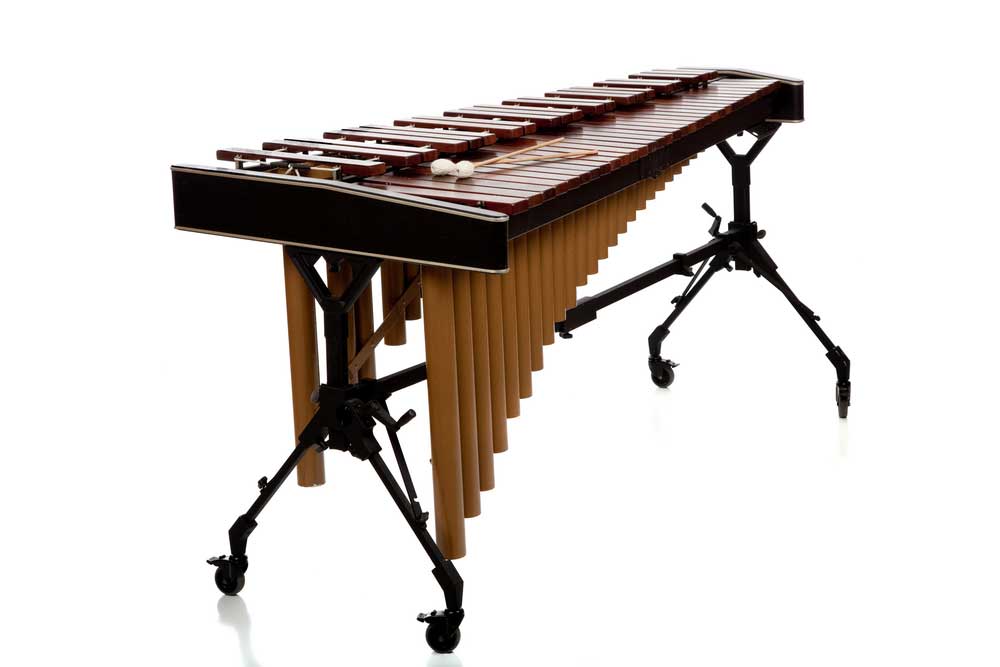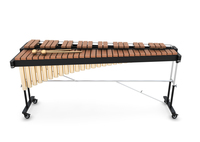Vibraphone
Melodic Percussions
America
Between 1901 and present
Video
The vibraphone is a captivating percussion instrument that combines musicality with intricate design. Known for its rich, resonant tones and unique vibrato effect, the vibraphone has become a staple in various musical genres, particularly in jazz and orchestral compositions.
Description and Features
The vibraphone is classified as a metallophone, which means it consists of tuned metal bars that produce sound when struck. Typically made from aluminum or aluminum alloys, these bars are arranged in a keyboard-like layout similar to that of a piano. The instrument usually spans three octaves, ranging from F3 to F6, allowing for a wide range of musical expression.One of the most distinctive features of the vibraphone is its resonator tubes. Each metal bar is paired with a resonator tube that amplifies the sound produced when the bar is struck. These tubes are typically made from aluminum and are open at one end while closed at the other. The length and diameter of each resonator are carefully calibrated to match the pitch of the corresponding bar, enhancing the overall sound quality.
What sets the vibraphone apart from other percussion instruments is its motor-driven rotating disks located above each resonator. When activated, these disks create a vibrato effect by periodically opening and closing the resonators. This unique feature gives the vibraphone its signature shimmering sound, making it instantly recognizable in various musical contexts.The vibraphone also includes a damper pedal similar to that found on a piano. When pressed, this pedal allows notes to sustain longer by preventing them from being dampened immediately after being struck. This capability adds depth to the instrument’s sound and allows for more expressive playing.
History and Origin
The vibraphone’s origins can be traced back to the early 20th century in the United States. It was developed as an evolution of earlier percussion instruments like the xylophone and marimba. The first known prototype was created by Herman Winterhoff in 1921, who designed an instrument with metal bars and resonators that produced a more refined sound than its wooden predecessors.In 1924, the instrument gained further prominence when it was patented by George E. Stone, who introduced electric fans that enhanced the vibrato effect. This innovation marked a significant turning point for the vibraphone, allowing it to produce sustained notes with a unique tonal quality. During the 1930s and 1940s, the vibraphone became increasingly popular in jazz music. Renowned musicians such as Lionel Hampton and Milt Jackson showcased its capabilities in their performances, solidifying its place in jazz ensembles.
The instrument’s ability to blend melodic lines with rhythmic patterns made it an ideal choice for improvisation.As jazz evolved through the decades, so did the use of the vibraphone. It found its way into orchestral compositions and contemporary classical music as composers began to explore its unique sound qualities. Today, the vibraphone is celebrated not only for its historical significance but also for its versatility across various musical genres.
Working Mechanism
The working mechanism of the vibraphone revolves around its combination of metal bars and resonators. When a player strikes one of the bars with mallets—typically made from rubber or yarn—the bar vibrates at specific frequencies to produce sound. The length and thickness of each bar determine its pitch; shorter bars produce higher notes while longer bars yield lower tones.The resonator tubes located beneath each bar amplify these vibrations. When air inside the resonator is set into motion by the vibrating bar above it, it creates standing waves that enhance the fundamental frequency of the note being played. This amplification results in a richer sound that can fill larger performance spaces effectively.The vibrato effect produced by the rotating disks above each resonator adds another layer to the instrument’s sound production. When activated, these disks oscillate rapidly, causing fluctuations in pitch that create a shimmering quality reminiscent of vocal vibrato. The speed at which these disks rotate can be adjusted using a control knob on the instrument, allowing musicians to tailor their sound to suit different musical contexts.Additionally, players can utilize various mallet types to achieve different tonal qualities. Softer mallets produce warmer sounds with fewer overtones, while harder mallets yield brighter tones with more pronounced high frequencies.
Types of Vibraphones
Vibraphones come in several types based on their construction materials and intended uses:
- Professional Vibraphones: These instruments are typically made from high-quality materials such as aluminum alloy bars and offer superior sound quality. They are often used by professional musicians in orchestras or jazz ensembles.
- Intermediate Vibraphones: Designed for advancing students or semi-professional players, these vibraphones strike a balance between affordability and quality sound production.
- Student Vibraphones: These instruments are generally more affordable and lightweight, making them suitable for educational settings where beginners can learn without investing heavily.
- Electric Vibraphones: Some modern versions incorporate electronic components that allow for additional effects or amplification options beyond traditional acoustic models.
Each type serves different purposes based on player skill level and musical context.
Uses of Vibraphones
Vibraphones are incredibly versatile instruments used across various musical genres:
- Jazz: The vibraphone is often featured prominently in jazz ensembles due to its melodic capabilities and ability to blend with other instruments seamlessly.
- Classical Music: Composers have incorporated vibraphones into orchestral works for their unique tonal qualities.
- Film Scoring: The ethereal sound of vibraphones makes them popular choices for film scores where mood enhancement is essential.
- Contemporary Music: Many modern artists use vibraphones in pop or experimental music settings to add depth and texture.
- Therapeutic Settings: Vibraphones are also used in music therapy practices due to their calming sounds that promote relaxation and mindfulness.
Significance of Vibraphones
The significance of vibraphones extends beyond their musical capabilities; they represent innovation within percussion instruments while embodying cultural heritage through their use in various genres. As an instrument deeply rooted in American jazz history, they continue to inspire new generations of musicians seeking creative expression through sound.In educational contexts, learning how to play the vibraphone helps students develop essential skills such as rhythm recognition, coordination between hands, ear training for pitch accuracy—all valuable assets for any aspiring musician.Moreover, as global interest grows around mindfulness practices like meditation or yoga sessions incorporating live music elements—vibraphones provide soothing sounds conducive to relaxation while enhancing overall experiences during these activities.
FAQ
What are the characteristics of a vibraphone musical instrument?
The vibraphone is a percussion instrument with metal bars arranged like a keyboard. It produces a resonant, mellow sound when struck with mallets. Key features include a sustain pedal that controls note duration and motorized resonators that create a vibrato effect. The instrument is widely used in jazz, classical, and contemporary music for its unique tonal quality.
What is the origin of the vibraphone?
The vibraphone was invented in the United States in 1921 by Herman Winterhoff at the Leedy Manufacturing Company. Originally designed for vaudeville performances, it quickly gained popularity among jazz musicians and later became an integral part of orchestral and contemporary music.
What are the types of vibraphone available?
Vibraphones are available in various configurations, such as 3-octave or 4-octave ranges. Standard acoustic models are used for traditional performances, while electronic vibraphones with MIDI capabilities cater to modern compositions. Differences in materials and designs also impact the instrument's portability and tonal characteristics.
 Links
Links
References
Other Instrument
Categories



















